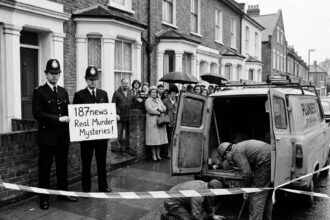A gruesome series of murders kept Britain in suspense for 16 months from the end of August 2014. During this period, four young gay men were killed in East London. The killer had met the victims via the gay dating app “Grindr” and then lured them to his apartment, where he administered a lethal dose of the designer drug GHB, also known as liquid ecstasy.
He then raped his victims. When they died of the overdose, the killer disposed of the bodies near the cemetery of St. Margaret’s Church in East London. To avoid arousing suspicion, he placed bottles of the drug next to the bodies to make it look like an overdose. This plan seemed to work at first, as the Metropolitan Police did not initially launch an investigation, despite the victims’ relatives expressing doubts about the overdose. When the body of 25-year-old Jack Taylor was found on September 14, 2015, next to a bottle of GHB for the fourth time in a few months, a murder investigation was finally launched, which quickly led to the perpetrator. Jack Taylor had been out with friends on the evening of September 12. This was confirmed by CCTV footage released by the police to help the public piece together Jack Taylor’s last activities. The footage also showed 42-year-old British man Stephen Port, who had been questioned by a police officer as a witness in connection with the death of 23-year-old Anthony Walgate. Anthony Walgate was the first body in whose trouser pocket a small bottle of GHB had been found. At the time, the police believed that Anthony Walgate had died of an overdose without any outside influence. Anthony Walgate’s body had been found on Cooke Street, not far from Stephen Port’s apartment. Because of this connection, Stephen Port came under the scrutiny of investigators and soon emerged as the “Grindr Killer,” as the press had dubbed the murderer. After the murder and rape of Anthony Walgate, Stephen Port’s second victim was 22-year-old Gabriel Kovari, whose body was found near the cemetery of St. Margaret’s Church by a 67-year-old woman walking her dog on August 28, 2014. The cemetery was only 500 meters away from Port’s apartment. Gabriel Kovari had lived with Port for a short time until he died of a GHB overdose, which he had not administered himself. Less than a month later, on September 20, 2014, the same 67-year-old woman found the body of 21-year-old Daniel Whitworth in the same cemetery while walking her dog. Next to Daniel Whitworth’s body was a suicide note stating that he had given Gabriel Kovari a lethal dose of GHB during sex. Feeling guilty about his death, he had now overdosed himself. Based on the letter, the police had no doubt that Daniel Whitworth had not killed himself. It was only when the fourth male corpse was found that the Metropolitan Police began to have doubts about the increasing number of deaths involving the drug GHB. In October 2016, Stephen Port, who had already come to the attention of the police three years earlier for sexually harassing other men, was arrested as a suspect in the four murders. In November 2016, Stephen Port was sentenced to life imprisonment at the Old Bailey court for 22 crimes against 11 men, including 4 murders, 4 rapes, 4 assaults by penetration, and 10 cases of administering GHB. Although Stephen Port will probably die in prison, as his release during his lifetime is out of the question, the Stephen Port case is far from over, as the police are now investigating another 58 unsolved deaths in which traces of the drug GHB were found in the victims’ bodies. Who knows how many more lives Stephen Port has on his conscience.
The Dating App Killer

Tagged:AileenWuornosAktuellesAlpenMysteryAngriffAntiterrorAttentateAutoeinbruchBankenVerbrechenCHBaslerBluttatenBayernKrimiBeklemmendSpannendBerichterstattungBernerMysterienBerühmteFälleDeutschlandBerühmteKriminalfälleBetrugBeweisaufnahmeBjarneMädelBlackDahliaBostonStranglerBRDVerbrechenBreakingNewsBrigitteHeikeBrunoLüdkeCelebrityCrimeCharlesMansonColdCaseColdCaseGermanyColdCasesColdCasesÖsterreichCommunityCrimeSolversCrimeDokuSchweizCrimeNeverSleepsCrimeSceneInvestigationCrimeSolveAttemptCyberCrimeDarknetDatenklauDatenschutzverletzungDDRVerbrechenDerMannimEisDetectiveWorkDetektivarbeitDetektivgeschichteDeutscheGeschichteDeutscheKriminalfälleDeutscherMordfallDiebstahlDigitalDetectivesDNAEvidenceDNARevolutionDrogenhandelnDrogenkartellDrogenkonsumDrogenmissbrauchDrogenschmuggelEchteVerbrechenEdGeinEinbruchEmdenMissbrauchsfallErmittlungenErmittlungsarbeitErmordetEvidentialBreakthroughExtremismusFacebookInvestigatorsFahndungFalcoMordtheorieFamiliendramaCHFanTreffenFemaleCriminalsFinanzbetrugFinanzverbrechenForensicScienceForensikForensikÖsterreichForensischeWissenschaftenFritzHaarmannGefährlicheDamenGefährlicheGifteGeheimnisseDerAlpenGeheimnisvolleVergiftungGeldwäscheGenferKriminalfälleGerechtigkeitGerichtsdramaSchweizGerichtsverfahrenGeschichtsverbrechenGesetzlosigkeitGewaltverbrechenGifteInDerKunstGiftigeRezepturenGiftMordGiftmordGeschichteGladbeckerGeiseldramaGlobalColdCasesGruseligeVerbrechenGruselnMitUnsHackingHamburgTrueCrimeHäuslicheGewaltHerculePoirotHinterkaifeckMordeHistoricalCrimeHistorischeVerbrechenHistorischeVerbrechenCHHistoryLover PastMysteriesIdentitätsdiebstahlInternetbetrugJackTheRipperJackUnterwegerJohnWayneGacyJonBenetRamseyJosefFritzlJugendverbrechenJürgenBartschJustizdramaJustizirrtümerJustizsystemKalteFälleDeutschlandKinderhandelKommissarBeckKommissarDupinKommissarMaigretKommissarWallanderKörperverletzungKreditkartenbetrugKrimiAutorenKrimiBuchKrimiDeutschlandKrimiDokumentationKrimiLiteraturKriminalfälleKriminalgeschichtenKriminalgeschichteÖsterreichKriminalitätNRWKriminalitätsgeschichteKriminalnachrichtenKriminalpolizeiKriminalpräventionKriminalpsychologieKriminalstatistikKriminelleAlchemieKriminologieKrimiPodcastsKrimiSchwarzwaldKrimiSerienKultkriminalfälleKunstraubLebachFallLiveBerichterstattungCHLocalColdCasesMagdaGoebbelsMysteryManfredScharfenorthMenschenhandelMilieuStudienMissbrauchMissingAustriaMissMarpleMittelalterlicheVerbrechenModerneGifteModerneSklavereiMordMordfälleMordlustMordundTotschlagMünchenMordMysteriöseFälleMysteriöseTodeMysteriousCaseMysteryInTheUSAMysteryLoverMysteryLoversAustriaNataschaKampuschNaturschutzdeliktNeuesNordicNoirNSUProzessOldCaseNewEvidenceOnlineBetrugOnlineSleuthingOpferhilfeOpferschutzOpferUndTäterOrganisierteKriminalitätÖsterreichMythenPeterKürtenPhilipMarlowePhishingPlünderungPodcastJunkiePolitThrillerSchweizPolizeieinsatzPolizeiruf110ProfilerÖsterreichProfilingPromiSkandalePsychologieDerVerbrechenPsychothrillerRadikalisierungRansomwareRateMitRaubRaubüberfallRauschgiftRechtsmedizinRedditDetectivesRichardRamirezSagenUndMärchenSchuldUndSühneSchweizerKriminalfälleSerienmörderSexhandelSherlockHolmesSicherLebenSpannungPurSpurensucheStarVerbrechenSteirischeVerbrechenStrafrechtSuchtTaschendiebstahlTäterprofileTatortTatortBerlinTatortBremenTatortDeutschlandTatortDortmundTatortGiftfläschchenTatortHistorieTatortKlassikerTatortKölnTatortKommissarTatortKrimiTatortMünchenTatortMünsterTatortsonntagTatortSpekulationenTatortStuttgartTatortuntersuchungTatortWeimarTatortWienTatortZeitTedBundyTerroranschlagTerrorismusTheSodderChildrenThrillerThrillerLesenTimeTravelDetectiveTirolerMysterienTödlicheKulisseTotschlagToxischeWahrheitTrueCrimeAddictTrueCrimeAusstellungenTrueCrimeAutorenTrueCrimeBlogsTrueCrimeBücherTrueCrimeCommunityTrueCrimeDeutschlandTrueCrimeDokuTrueCrimeEventsTrueCrimeFandomTrueCrimeGiftTrueCrimeÖsterreichTrueCrimePodcastTrueCrimePodcastsCHTrueCrimeSchweizTrueCrimeSerieTrueCrimeStoriesTrueCrimeYouTubeUmweltverbrechenUmweltverschmutzungUngeklärteFälleUngeklärteFälleSchweizUnsolvedEuropeUnsolvedMysteryUnterschätztesGiftUrbanLegendsAustriaVandalismusVerboteneLiebeVerbrechenVerbrechenDerMächtigenVerbrechenIm19JahrhundertVerbrechenInBerlinVerbrecheninDeutschlandVerbrechenInWienVerbrechenUndStrafeVerbrechenVonNebenanVerbrecherjagdVergewaltigungVergifteteLiebeVermisstenfälleVersicherungsbetrugVerurteiltDerPodcastVintageCrimeVorsichtGiftWahreVerbrechenWaldbrandstiftungWarumMenschenTötenWildereiWirtschaftskriminalitätZeitVerbrechenZodiacKillerZürcherKrimiZwangsarbeit








